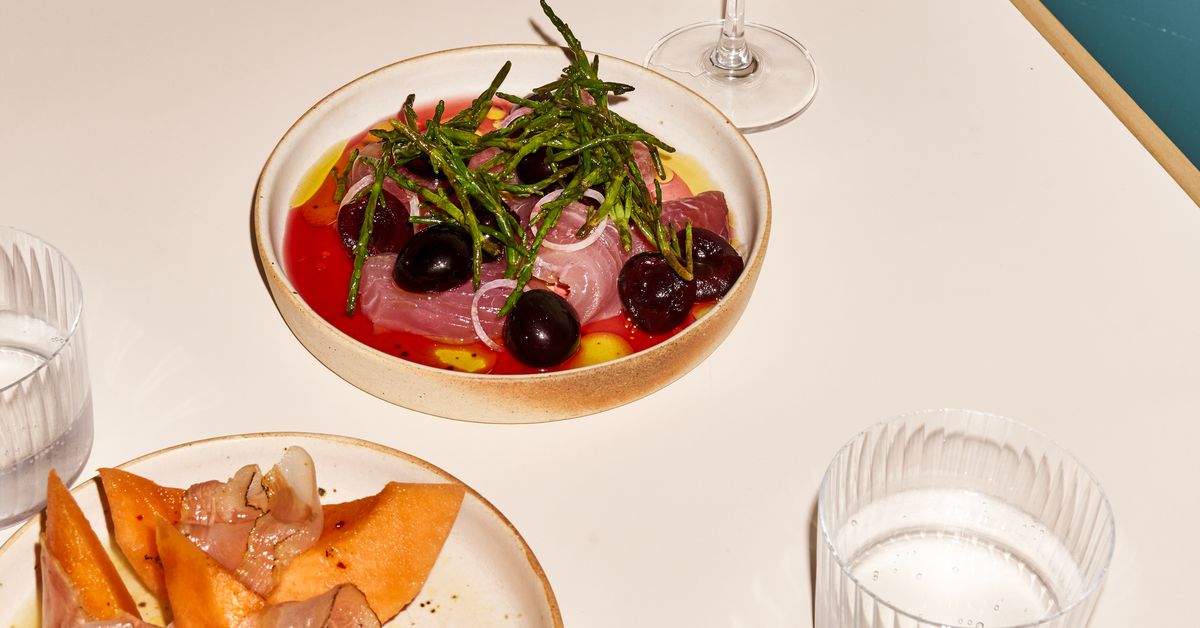Fernando “Fefo” Aciar has owned Ocafe, a Latin American brewed coffee mainstay in the West Village, for a decade, but in May of this year he launched Ostudio at Night, a new restaurant and wine bar in Brooklyn that puts pop-chefs at the forefront.
Located on the border of Bed-Stuy and Bushwick, Ostudio offers its set coffee and dinner menu – from chef Omri Silberstein, a former June Wine Bar – in tandem with dozens of pop-ups timed as one-day events. night only or longer residencies spanning several weeks. The restaurant has featured established and lesser-known chefs who work in conjunction with Ostudio’s kitchen staff to create their own short-term menu takeovers. One night, diners might find baked Alaska with corn ice cream; another night, a black sesame custard with chilli peanut candies – meant to accompany a bottle of natural wine.
Ostudio at Night offers one of Brooklyn’s most robust pop-up programs, a growing trend among New York City restaurants that includes Winona’s, a Bed-Stuy restaurant known for its pop-ups, as well as King Tai, a bar of Crown Heights which invested more in its pop-ups by building a full kitchen on the second floor this summer. There’s also Fulgurances Laundromat, which opened in Greenpoint last year, an outpost of a popular French restaurant that changes its menu every two months. Rhodora Wine Bar opened just before the pandemic hit, but it’s making progress with its accelerated pop-up program. Meanwhile, the Crown Heights Daughter cafe lends its space to pop-ups to help attract dinner customers, often serving as a platform to raise money for local causes.
:no_upscale()/cdn.vox-cdn.com/uploads/chorus_asset/file/23984142/Giada_Paoloni_x.jpg)
With all of its multidisciplinary parts, Ostudio is an ambitious, creative, and well-designed experience — a canvas for some of Brooklyn’s most exciting pop-ups, alongside daily bar bites that can stand on their own. All in all, it offers a chance to nab a showcase of up-and-coming talent in a restaurant formatted for fun – but what that will be is yet to be determined. Models like Ostudio at Night demonstrate the tension of relying on the work of guest chefs without being extractive – in an industry notoriously thin-margined.
Not every restaurant that has built business models around pop-ups has figured out what is emotionally and financially viable, both for themselves and for pop-up operators. Hunky Dory and KIT, closed during the pandemic, despite being darling pop-up hubs. At the other end of the spectrum, after being overtaken by the New York Times as the “restaurant of the summer”, the Outerspace residence space imploded last summer – during which Eater reported that former staff members also encountered problems with the direction of the assault and said they had not listened to grievances about working conditions.
Whether things will be any different for Aciar and his collaborating chefs remains to be seen, particularly when it comes to fair compensation for all parties. Throughout the city, some venues hold drink sales; others give pop-ups money from food sales, while others take a percentage of total sales. A handful of places give space for free. Ostudio at Night takes a percentage of food and drink sales (more than 10%); for residences, chefs receive a lump sum for a few weeks. In a few cases, for less established pop-ups, Aciar says it offers the space for free.
“Ostudio was introduced to us and something that really stood out to us was the community. It has ceramic and artist studios, kitchen upstairs and downstairs, all these multiple platforms really resonated with us,” said Andrew Ceneus, co-founder of the self-help organization Food With Fam, which hosted an event at Ostudio that raised money for food distribution at the Sumner Houses. of Food With Fam is about building community and sharing resources, and we rely on partners to do that,” says Ceneus, who said he would be eager to return. He tells Eater that their team has seen offered free space and bought wine from Ostudio to serve.
Some popups praised Ostudio at Night for its lofty goals and noted that it could be a cool stepping stone, but told Eater they would wait for Ostudio to do some back-end troubleshooting on the organization and financial agreements before proceeding. consider signing or returning. .
:no_upscale()/cdn.vox-cdn.com/uploads/chorus_asset/file/24002133/Gentl_Hyers1.jpg)
One of the ways Ostudio seems to be useful is to set up a platform for chefs who might still discover their culinary vision for testing recipes and for a potential restaurant. Such was the case with the next East Village restaurant, Caleta, which Ostudio hosted in August, as they worked to put together a tasty menu.
“Until now, because we’ve been wholesalers and retailers, we’ve been working and delivering ice cream…it’s been great to have full conversations and connect with customers,” says Jesse Merchant Zuñiga, half of the brand of ice cream. Bad Habit, which will be produced in Caleta. Customers who found out about the space through word-of-mouth or Instagram “were really excited to be there and curious,” she says.
Other chefs who have cooked at Ostudio, like Woldy Reyes, have no imminent plans to return to traditional restaurants. Despite the grueling amount of work that goes into it, he says he sees pop-ups as an alternative setting for culinary aspirations. For him, the Ostudio residency allowed him “to be more experimental and to have a space to exercise his creativity”, without worrying so much about having “butts in the seats”.
For customers, the changing menu means there’s something to try every visit and growing reasons to bring friends.

